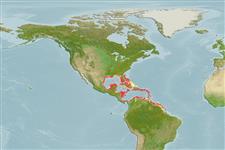Common names from other countries
>
Clupeiformes (Herrings) >
Dorosomatidae (Gizzard shads and sardinellas)
Etymology: Harengula: Old English haring, hering = mackerel, the fish Clupea harengus (Ref. 45335).
More on author: Cuvier.
Environment: milieu / climate zone / depth range / distribution range
Ecología
marino; salobre asociado a arrecife; rango de profundidad 0 - 50 m (Ref. 188). Subtropical; 31°N - 7°S, 99°W - 47°W (Ref. 188)
Western Atlantic: Gulf of Mexico and southeastern Florida to northern Brazil, including the Bahamas, the entire Caribbean and the West Indies.
Length at first maturity / Tamaño / Peso / Age
Maturity: Lm ?, range 7 - ? cm
Max length : 22.5 cm TL macho / no sexado; (Ref. 126891); common length : 10.0 cm SL macho / no sexado; (Ref. 188); peso máximo publicado: 109.00 g (Ref. 126891)
Espinas dorsales (total) : 0; Radios blandos dorsales (total) : 15 - 21; Espinas anales: 0; Radios blandos anales: 12 - 23. Tooth-plate on tongue and tooth plate behind it (basihyal and basibranchials tooth plates) broad, their width about 3 to 5 times in their combined length, the basibranchial tooth plate with a distinct bulge in front. Scales fairly strongly attached, not easily lost. No dark pigment on dorsal fin tip (Ref. 188). Silvery, with a dark greenish back. Diffuse yellow or pale orange spot at edge of opercle. Body slender, lower profile not strongly curved (Ref. 7251).
Occurs in coastal waters, estuaries and lagoons, tolerating low salinities. Can tolerate a broad range of salinity levels (Ref. 26938). Forms schools, small individuals often along sandy beaches. Its flesh has an unpleasant odor. Utilized as fishmeal (Ref. 5217).
Life cycle and mating behavior
Maturities | Reproducción | Spawnings | Egg(s) | Fecundities | Larva
Whitehead, P.J.P., 1985. FAO Species Catalogue. Vol. 7. Clupeoid fishes of the world (suborder Clupeoidei). An annotated and illustrated catalogue of the herrings, sardines, pilchards, sprats, shads, anchovies and wolf-herrings. FAO Fish. Synop. 125(7/1):1-303. Rome: FAO. (Ref. 188)
IUCN Red List Status (Ref. 130435)
CITES (Ref. 128078)
Not Evaluated
Threat to humans
Harmless
Human uses
Pesquerías: escaso valor comercial; carnada: usually
Herramientas
Special reports
Download XML
Fuentes de Internet
Estimates based on models
Preferred temperature (Ref.
115969): 24.3 - 28, mean 26.8 (based on 230 cells).
Phylogenetic diversity index (Ref.
82804): PD
50 = 0.5625 [Uniqueness, from 0.5 = low to 2.0 = high].
Bayesian length-weight: a=0.00891 (0.00791 - 0.01004), b=3.05 (3.02 - 3.08), in cm Total Length, based on LWR estimates for this species (Ref.
93245).
Nivel trófico (Ref.
69278): 3.3 ±0.3 se; based on diet studies.
Resiliencia (Ref.
120179): Alto, población duplicada en un tiempo mínimo inferior a 15 meses (Preliminary K or Fecundity.).
Fishing Vulnerability (Ref.
59153): Low to moderate vulnerability (28 of 100).
